Think back to the last time you learned a new skill. How much of your preparation came from simply reading training materials? How much of it came from trying it out for yourself and learning by doing?
Learning is a process, and the application and reflection phases are key to cultivating prepared, confident learners. But it’s not always realistic, or even safe, to teach new skills in the actual environments in which they’re applicable.
That’s where scenario based training comes in. Scenario-based learning is an interactive instructional strategy that uses real-life situations and narratives to actively engage learners. It’s hard to beat the engagement quotient of scenarios, and they’re a proven strategy for boosting learning outcomes. Think about your own approach to scenarios. Are you making the most of scenario-based learning?
We love using scenarios in our learning experiences—they’re a great solution for all kinds of industries and learning objectives. We’ve rounded up some of our favorite scenario based training examples to inspire you to take your learning even further. Let’s take a look at five scenario examples and how they elevated the learning experience.
1. Scenario example for safety and emergency procedures
Need to train team members on how to keep themselves and others safe? Telling them what to do in an emergency or crisis situation usually isn’t enough. People often learn best by doing, but how can you put their safety and emergency procedure skills to the test without putting them or others at risk?
Scenario-based learning is a great way to immerse learners in a realistic yet controlled environment where they can practice skills, play out different situations, and build their confidence. When a crisis occurs in actuality, they’re better prepared to respond without making critical mistakes.
Barton Health safety training
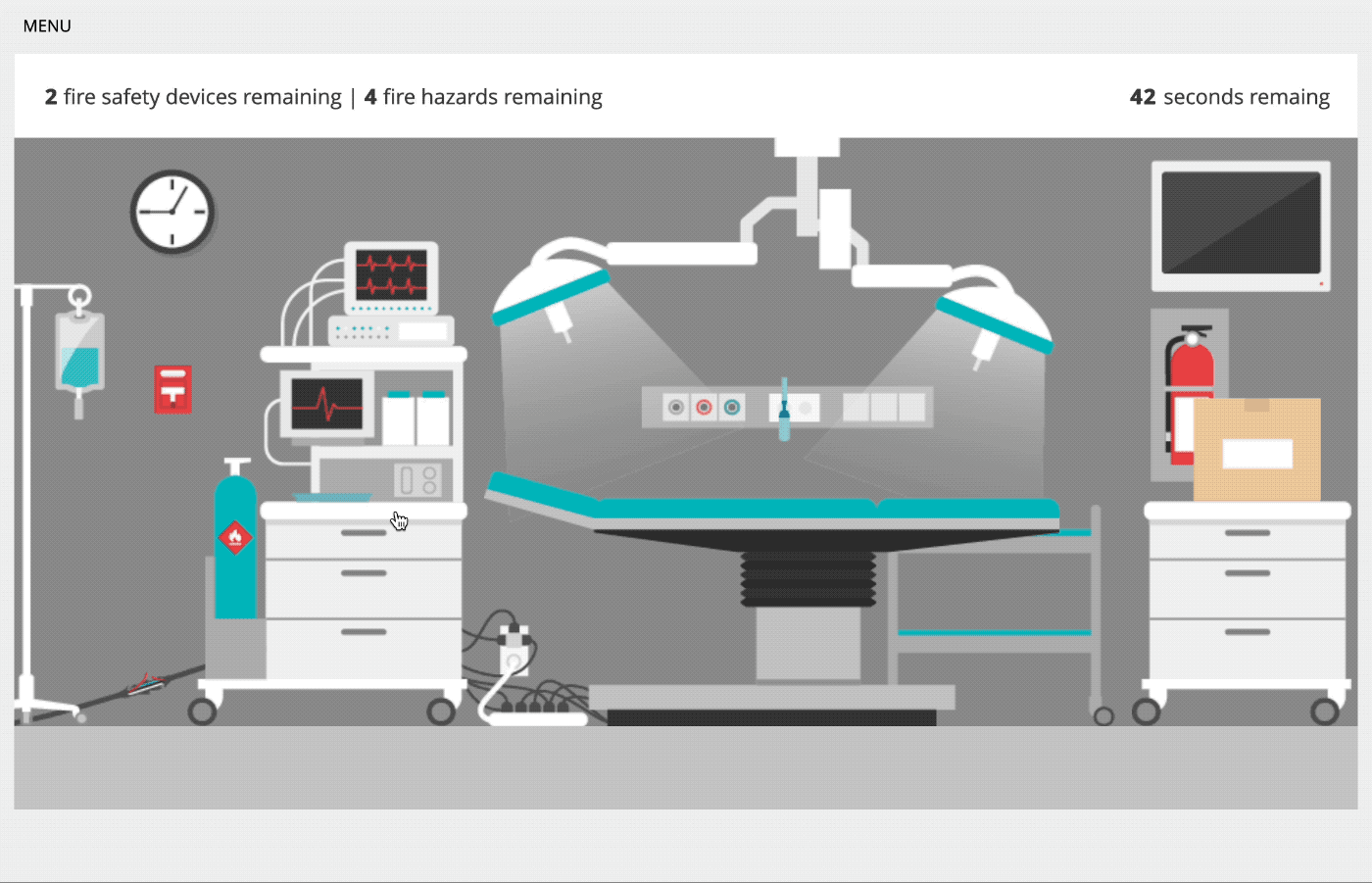
Barton Health needed to train team members on Fire Safety, Medical Equipment Safety, and Radiation Safety. Rather than create a standard compliance course that simply tells the learner how to behave safely, we created an interactive experience where they could identify and manage risks in a simulated healthcare environment.
In this learning experience, users are introduced to a realistic situation at the Barton Health campus: an electrical issue is causing problems in key areas of the hospital. They must make a series of decisions to prevent damage to the building and its equipment by stabilizing two key rooms in the building: the Operating Room and the MRI Room. Each room in the scenario is depicted by illustrations.
In the Operating Room, the learner is prompted to review the fire safety procedures and then identify the items in the room that are fire hazards (while the clock is ticking!). If they identify all items in the room before time runs out, they’ve successfully stabilized the Operating Room and can move on to the MRI Room. If they run out of time, they restart the room and try again. That’s the beauty of a scenario—failing is risk-free and you learn from the consequences.
Before moving on to the MRI Room, the learner is instructed to select the items on their person that need to be removed—all metal objects need to be removed before entering. They then need to select the MRI Technician to gain approval for entry.
Once in, they’re told that the machine is malfunctioning and are challenged with taking the proper steps to safely resolve the situation. If the user completes the required steps in the right order and before the clock runs out, they’ve stabilized the room and won the game. If not, they’re back to the beginning to give it another try.
Like all good scenarios, these scenario examples focus on application. Learning with context often yields much better outcomes, especially when the stakes are high. Setting your scenario in a simulated real-world environment makes it that much more memorable and relatable for learners.
Create enviable courses in Rise
Are you a learning designer who loves trying new things in Articulate Rise? Then you’re going to love Mighty, a powerful little Google Chrome extension built to help you do more in Rise. With Mighty, you’ll get access to exclusive features and functionality that elevate visual design, increase efficiency, and deliver better learner experiences. You can try Mighty for free right now and find out for yourself—start your free trial today!
Learn more + sign up→
2. Scenario example for social media conduct training
Global brands almost always have a strong presence across social media platforms, and even something as simple as liking a post on social media can have an enormous effect on the business they do.
Scenarios can help team members feel confident about what they can and can’t post on social media, whether they’re representing the brand or on their personal accounts. You could equip team members with a lengthy social media handbook and trust that they’ll review and retain it on their own—but learning by doing is a better way to translate those practices into real-world situations.
Here’s an example of a scenario for sharing smart social media practices with employees.
Social media best practices training
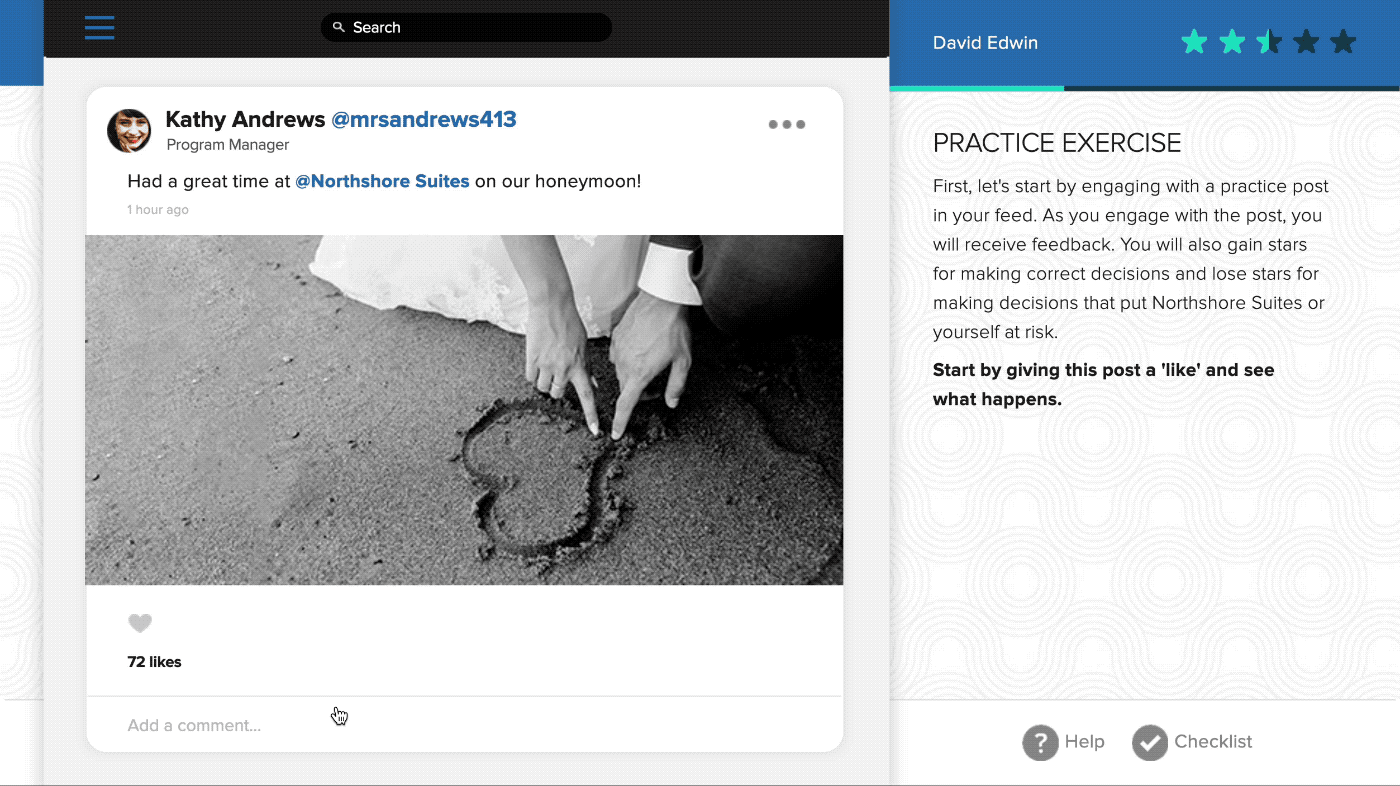
We partnered with a global hospitality brand to create a social media best practices training that would empower team members to maximize their engagement on social media and avoid unanticipated negative outcomes.
We designed scenario-based training that would inform team members of the brand’s social media best practices and give them an opportunity to practice their knowledge in a low-stakes simulated environment. We created two Articulate Rise modules that explained principles and policies and three Articulate Storyline modules that allowed learners to practice and demonstrate their mastery of the content through challenging and realistic scenarios.
To accomplish this, we replicated the experience of a social media platform. Learners interacted with the modules by liking, commenting on, or sharing posts—the same way they would on social media—and then learned from the immediate consequences of their actions.
Learners began each lesson by adding their name and favorite brand, and these items were featured throughout the training to increase the personalization of the training. As the training progressed, learners navigated complex branching scenarios, with the option to repeat scenarios and choose different responses to understand the downstream impacts of their choices.
3. 3D scenario for lab safety training
Safety is top priority in lab settings—is sharing a handbook with employees enough? Often, safety training is stickier when you give learners the chance to apply safety protocols in a realistic yet safe simulated environment.
Let’s take a closer look at how to use scenario learning to build confidence around lab safety.
Cubist lab safety training
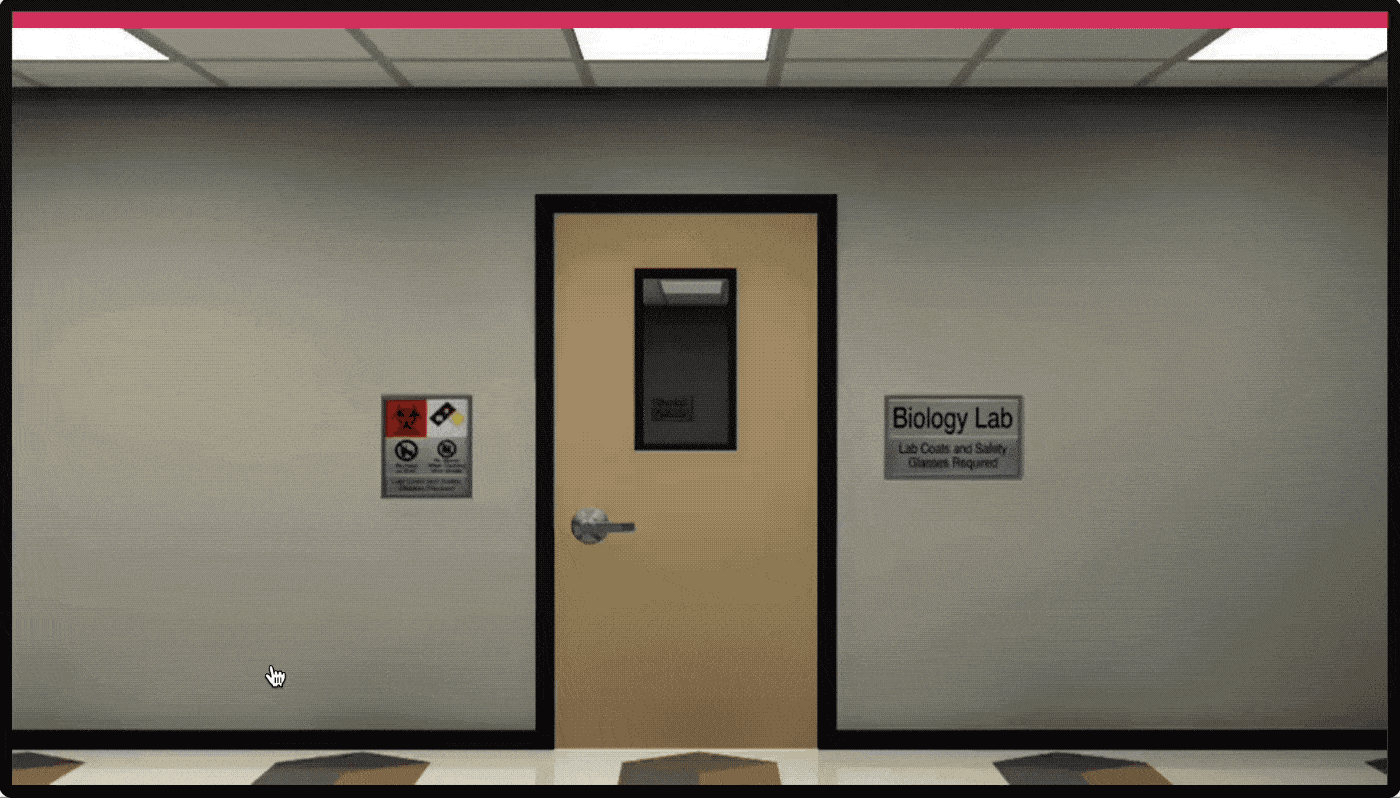
Cubist needed to train employees on how to identify hazards and address them in the appropriate manner. Instead of having learners simply read up on the potential hazards and proper responses, we created an Articulate Storyline course with 3D-rendered cut-scenes that required the learner to apply their knowledge in a simulated lab environment.
Here’s how it works. Learners enter a biology lab and move their cursor over any object or area where they observe a possible safety hazard, selecting anything they believe to be unsafe. If something is in fact unsafe, learners are given several options and choose the best way to correct it. Each option has feedback so they can learn more about each hazard and how to respond. Once they’ve identified and corrected all five hazards, they move on to the chemistry lab to repeat the exercise, with an emphasis on chemical safety.
This is one of our favorite scenario based elearning examples because it requires learners to go beyond acquiring knowledge and apply what they’ve learned. Plus, the 3D renderings in this scenario help to create a true-to-life representation of the lab and actual issues that learners might find themselves facing on the job.
4. Gamified scenario for exploring career paths
If your top priorities are to motivate and engage learners, try incorporating gamification into your scenario. Gamification uses elements like characters, narrative, and rewards to help immerse learners and capture their interest.
Let’s take a look at an example of a scenario that uses gamification to inspire employees to envision their future career paths.
CSL developing people game
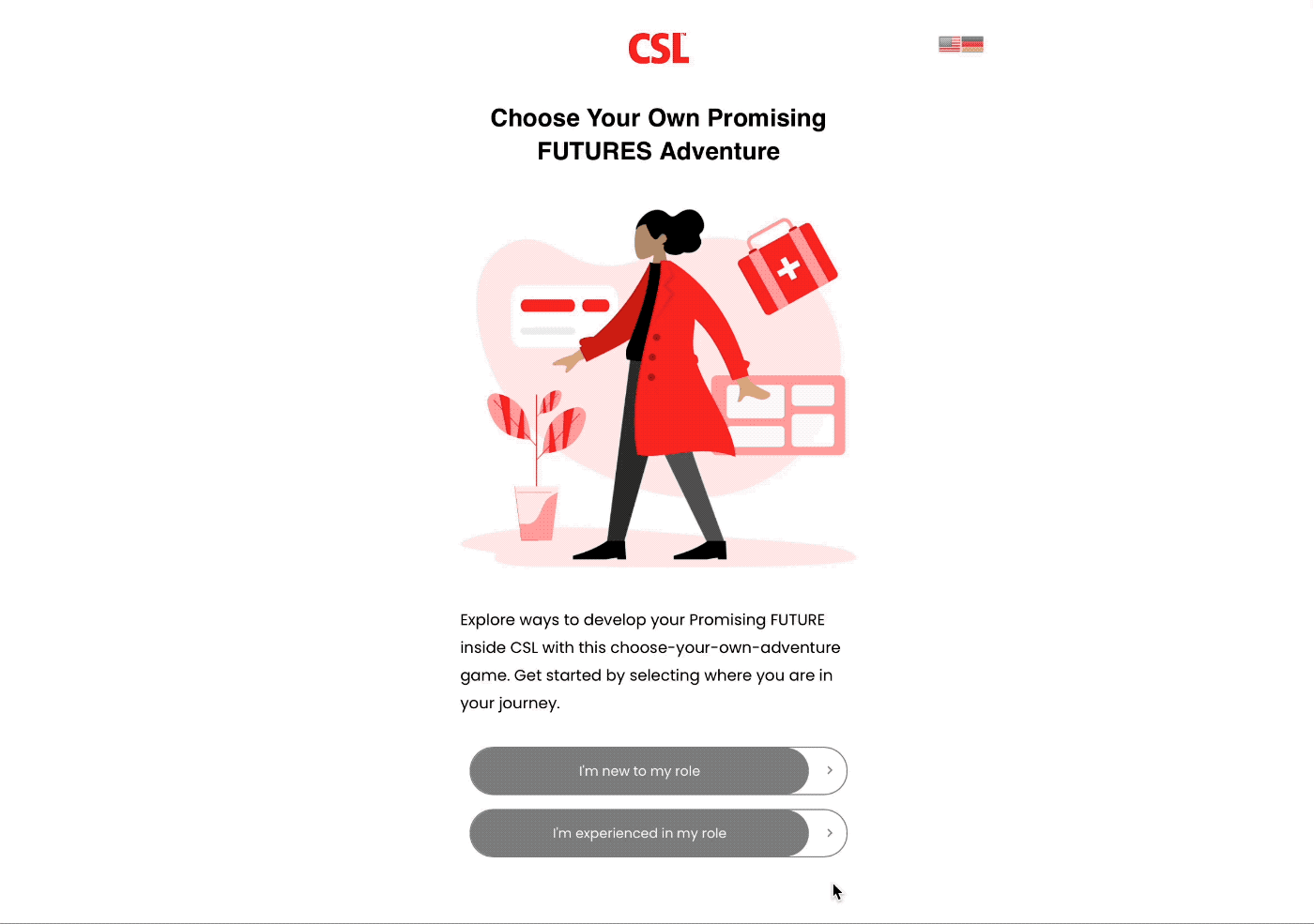
CSL is one of the largest and fastest-growing biotechnology businesses and a leading provider of in-licensed vaccines. CSL came to us looking for a thoughtful eLearning solution that would inspire its workforce to imagine their career paths and the many ways in which they can expand their skill sets and grow their careers within CSL.
We decided to take a unique, gamified approach with a choose-your-own-adventure style game that gets users to explore options for their long-term career path at CSL, based on their perceived strengths, skill sets, and goals. Once we determined the paths and events along their journey, we designed characters, events, and player interactions.
Users start by selecting where they are in their CSL journey. From there, they engage in a 10–15 minute experience, making decisions on interactive career pathways that help them travel through their career lifecycle and visualize their future with CSL. The experience served a global, virtual audience of 27,000 employees and required us to conduct a thorough exploration of roles and pathways within CSL.
The outcome? We were able to leverage gamified scenario learning to immerse learners in a positive vision of their futures with CSL and inspire them to start taking steps to make it a reality.
5. Scenario example for explaining complex processes
Product flow is complicated. In order to get it right, learners need to visualize how goods will move from supplier to consumer and all of the small decisions along the way that impact the journey. When it comes to simplifying complex processes, video-based scenario training is a great way to show and not tell and allow learners to think through real-world decisions.
Take a look at one example for using live videos in a scenario.
Product distribution onboarding
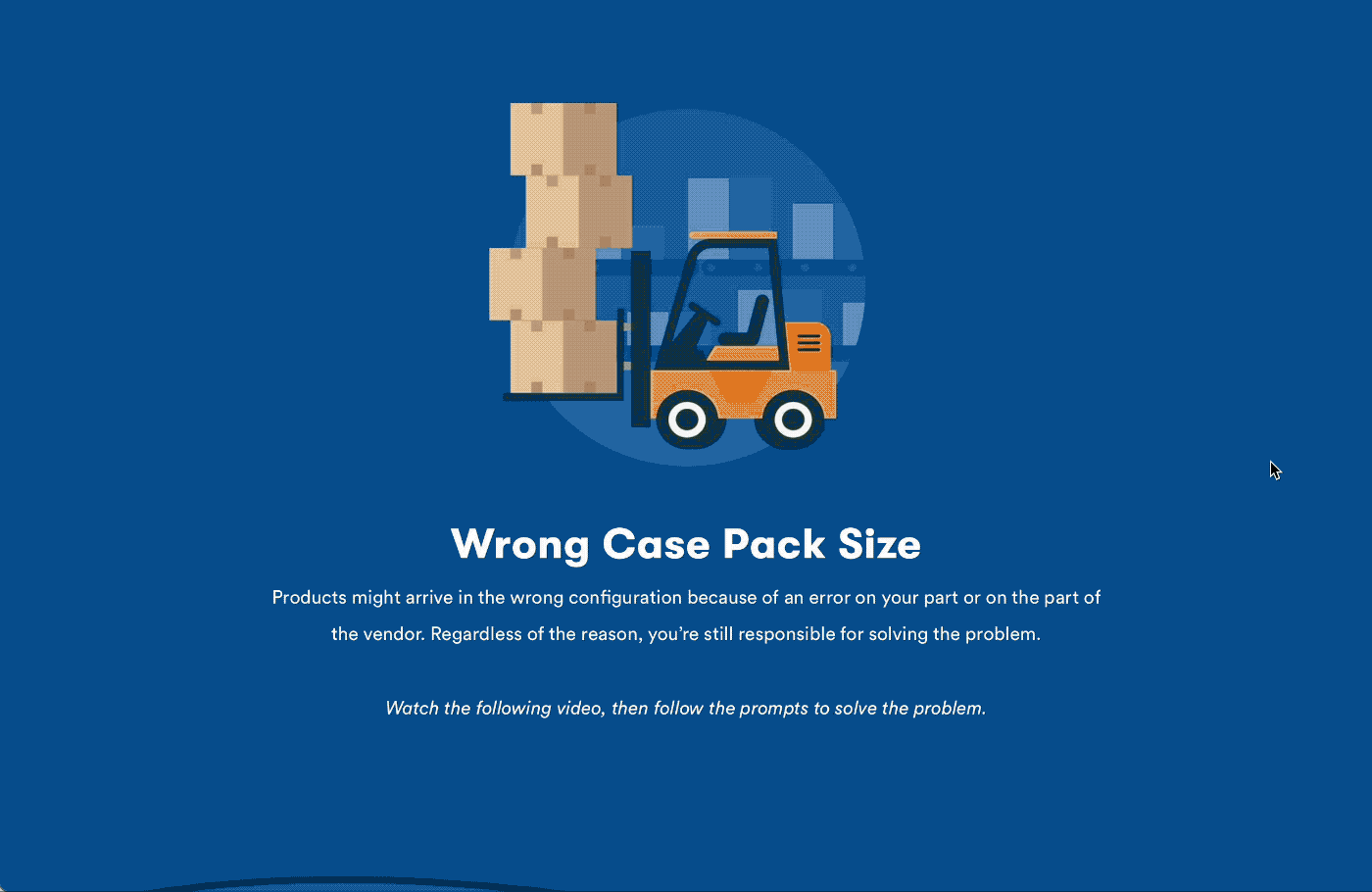
As part of onboarding, business analysts and buyers at a regional grocery store chain needed to understand the overall product flow from distribution facility to store. This brand believes in investing in its talent, and they often promote from within. That means people entering these roles are often more junior employees with little experience in distribution facility operations.
It’s a complex undertaking, and it’s critical for new hires to understand how the decisions they make from HQ directly impact the overall product flow. The decisions they make influence which products are available to customers in-store, which ultimately impacts the customer’s overall experience. Those are high stakes, and we knew it would take an immersive and engaging learning experience to help train the company’s BAs and buyers for success.
For this training, we created live-action videos to depict three unique scenarios. Our goal was to show learners how a product moves from distribution to stores and provide examples of critical decisions they’ll face to make the process run more smoothly. We made sure the videos seamlessly represented the store, the distribution facility, and HQ in order to visually show how each one impacts the other.
Nobody likes watching boring videos, so we took a fun and cheeky approach to these scenarios. We used actual company employees as actors (plus some Maestro team members!) to set up three situations, then prompting the learner to choose the best approach to resolve the problem. After the learner makes a decision, a summary video shows the outcome of all three presented options, highlighting which approach is best and why.
Especially when a learner is new to a role, it’s challenging to see the full scope of your decisions and influence. These video-based learning scenarios helped learners to transcend their environment and think beyond the walls of HQ. The training helped them see the big picture and explore why seemingly viable approaches might not be the best choice after all.
Scenarios prepare learners for success
For learning to be effective and really change the way we think and act, it needs to account for the way our brains process and absorb new information. These scenario examples serve as inspiration to show what’s possible in eLearning. Scenario-based learning is powerful: learners can practice their skills, learn from the consequences, and repeat the exercise until they get it right.

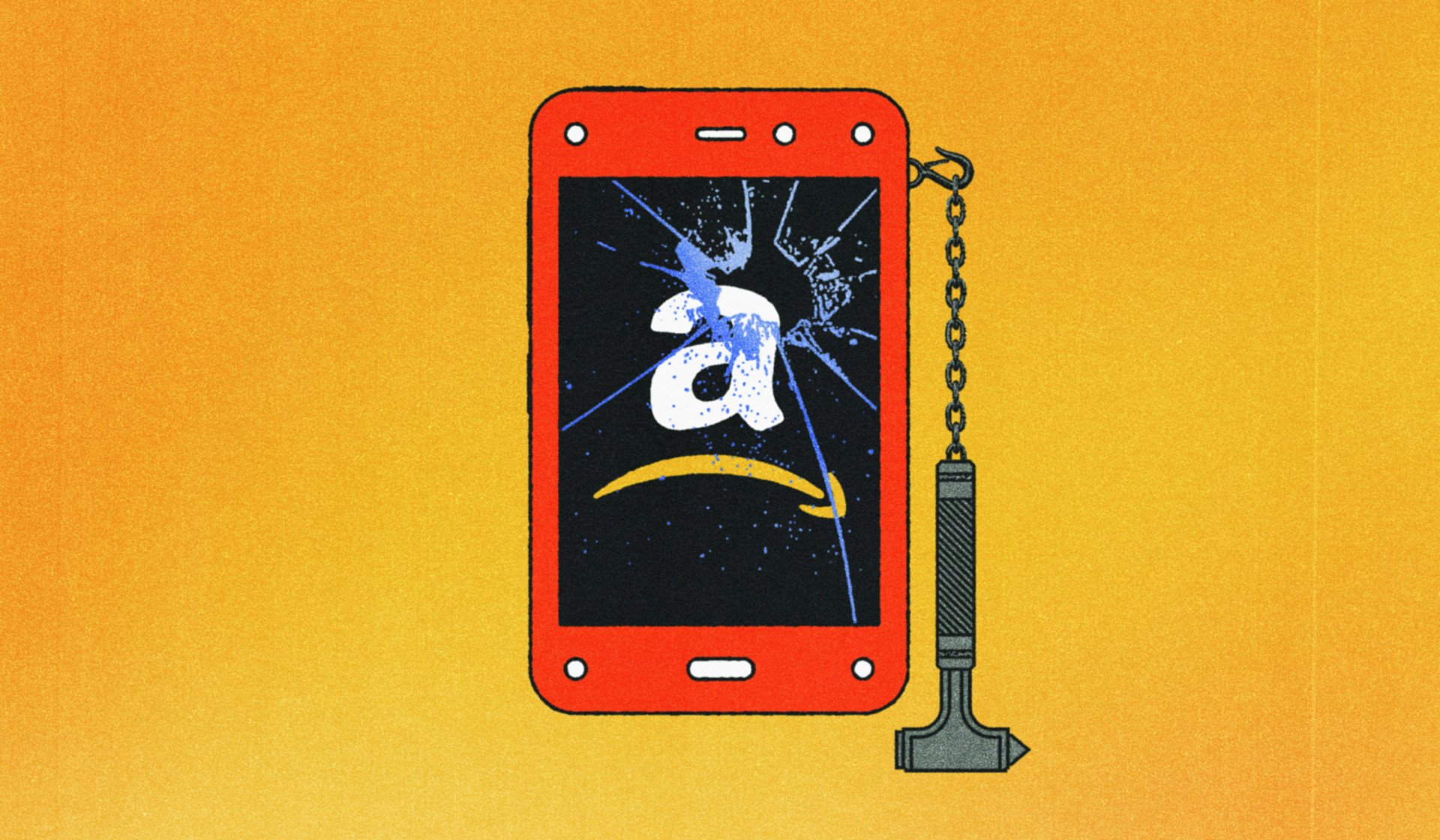


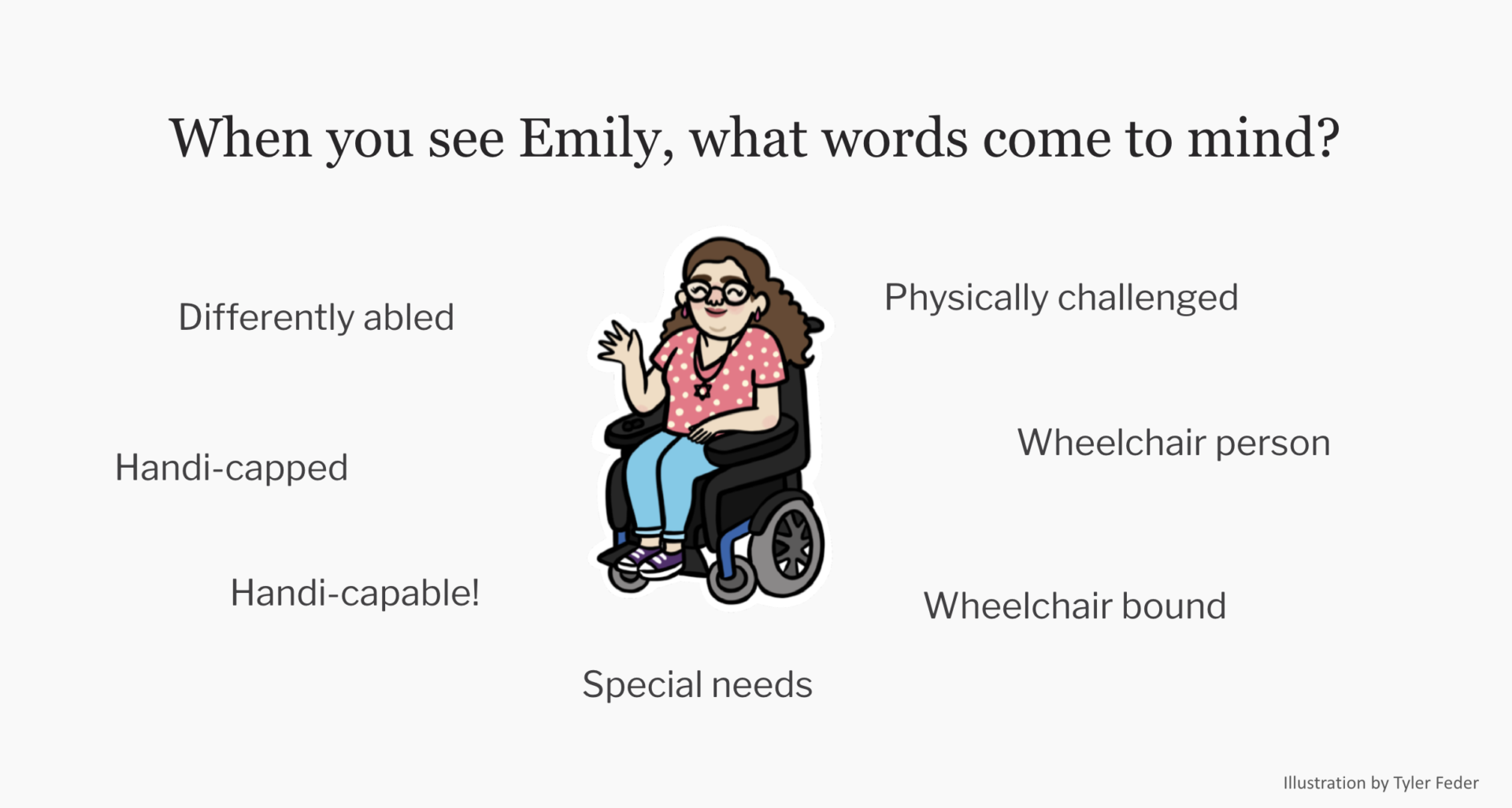
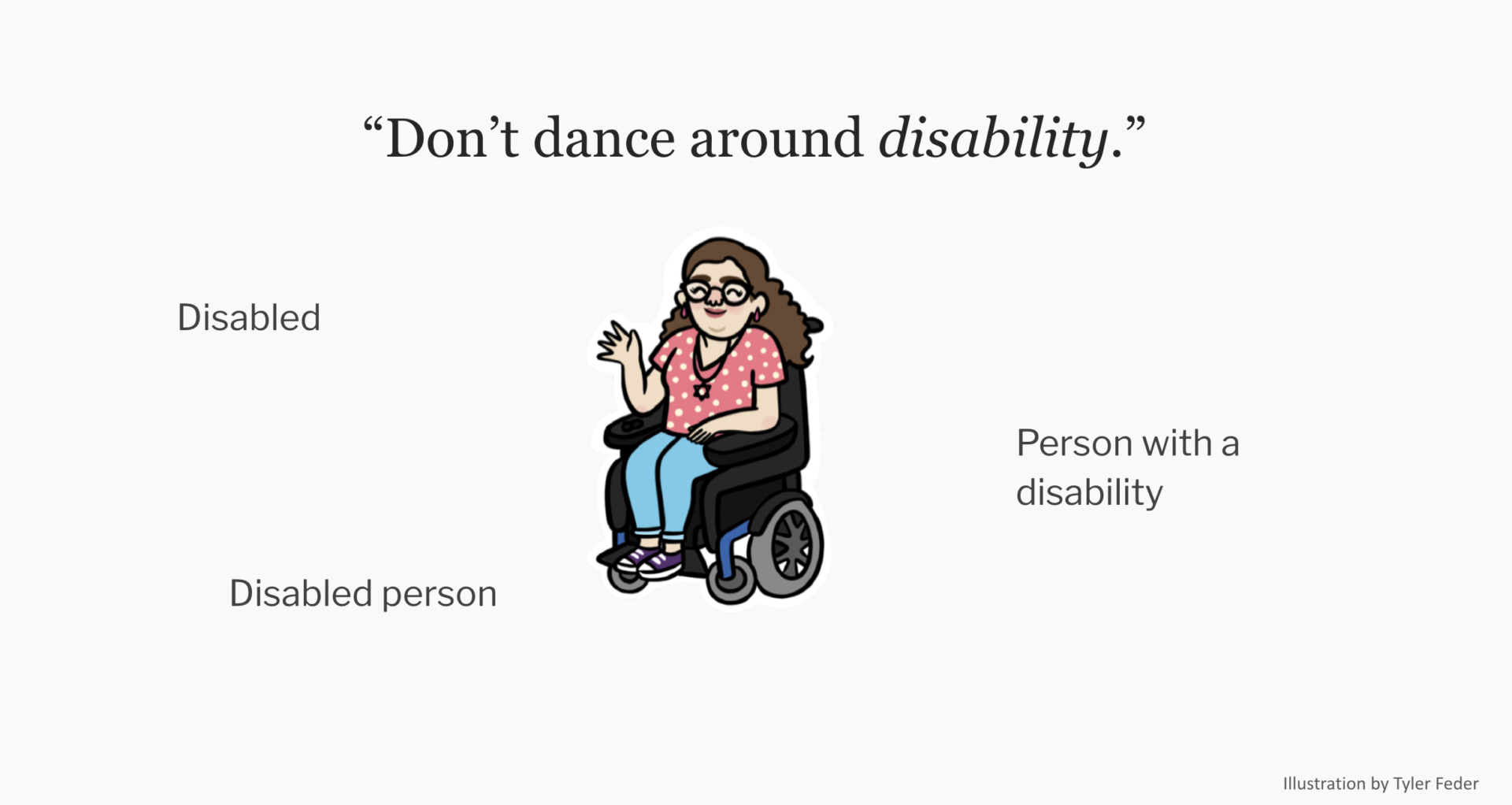




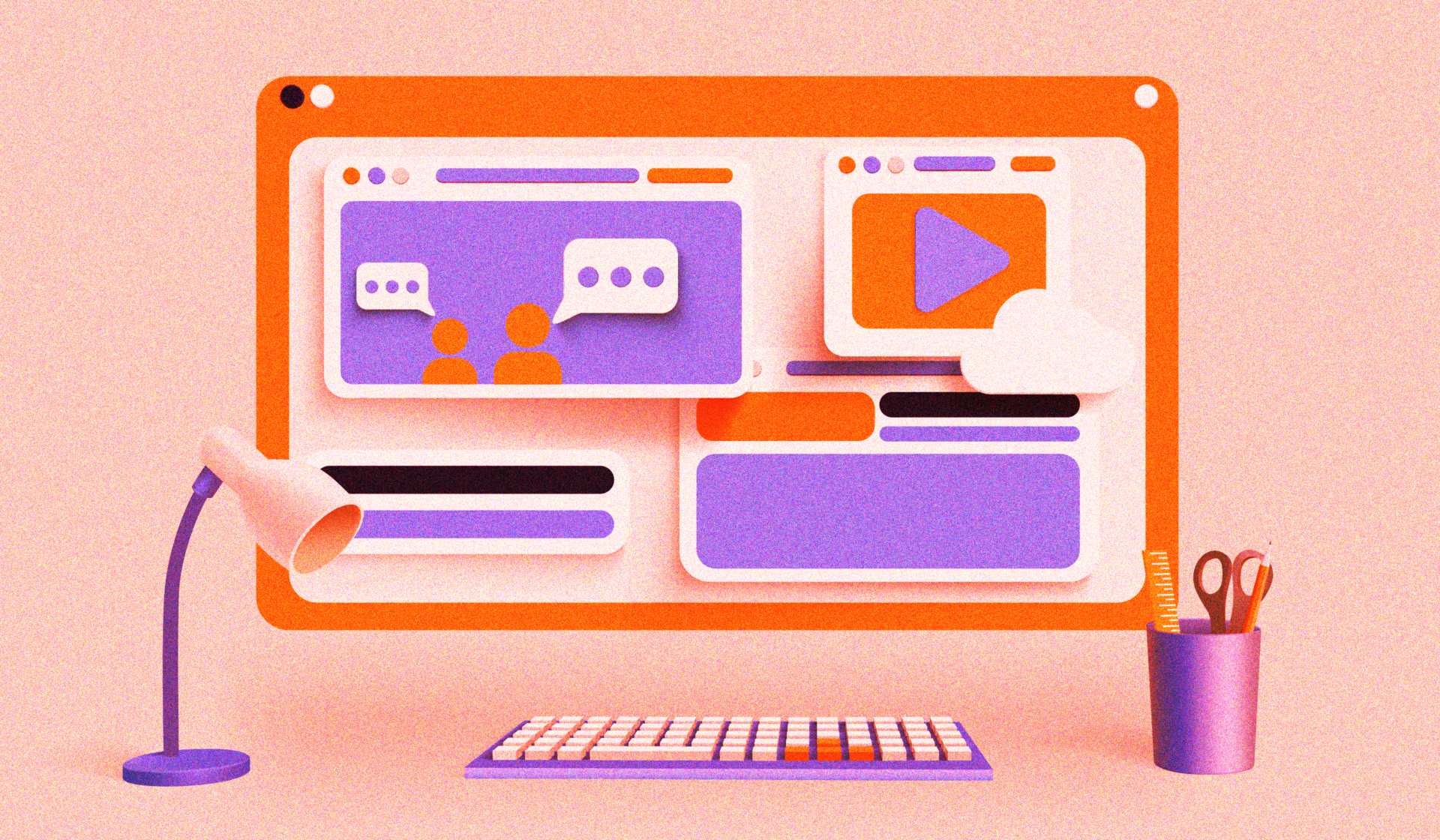





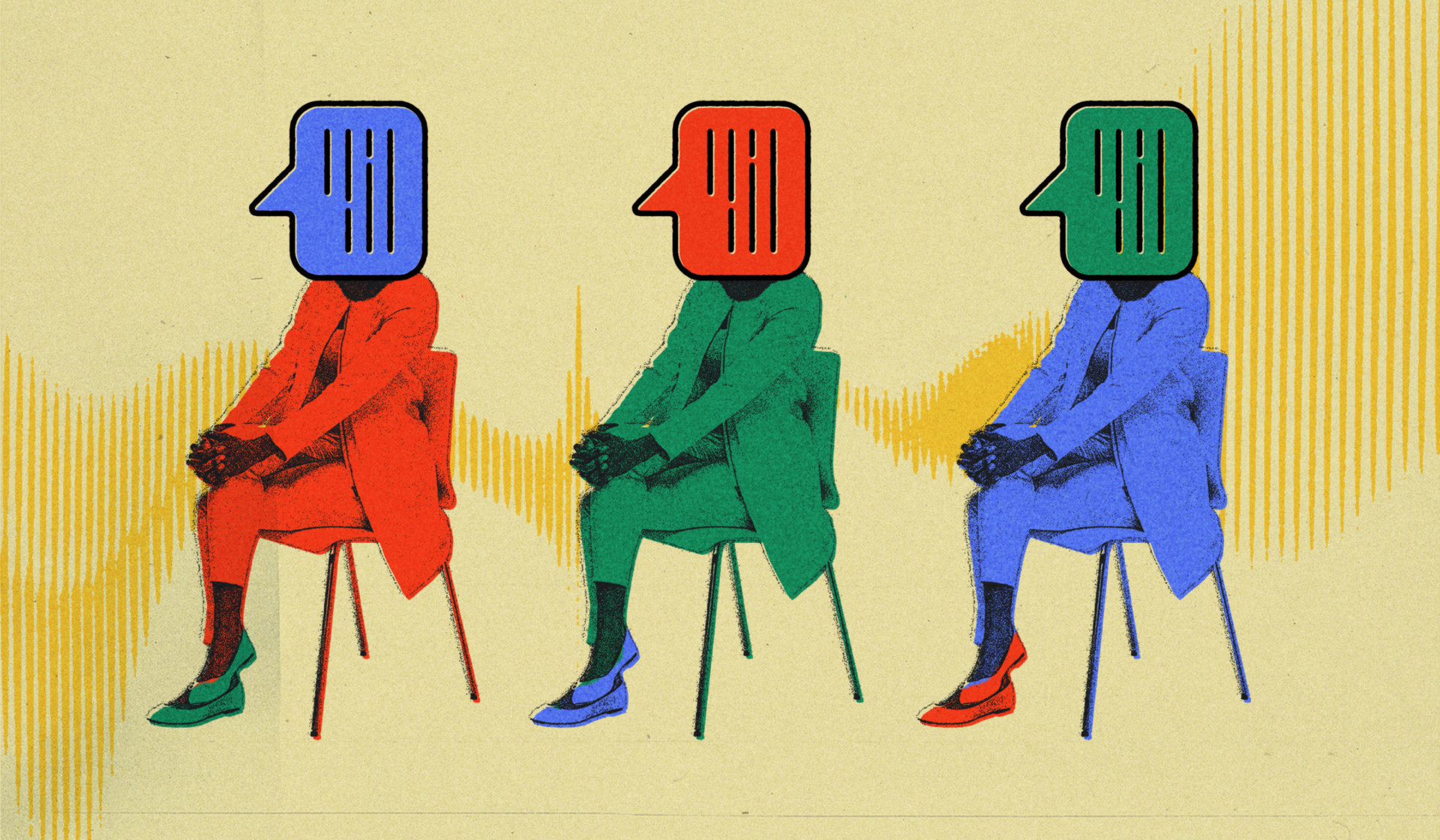
![the kirkpatrick evaluation model with an image of an eye saturated with color above each level in the model [1. reaction 2. learning 3. behavior 4. results]](https://maestrolearning.b-cdn.net/wp-content/uploads/2021/05/the-kirkpatrick-evaluation-model-with-an-image-of-an-eye-saturated-with-color-above-each-level-in-the-model-1.-reaction-2.-learning-3.-behavior-4.-results.png)
